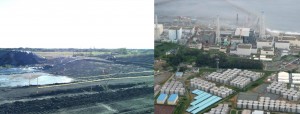Why Does The Frisco City Council Want to Build a Lead Fukushima in the Middle of Town?
 On Monday the Washington Post published a comprehensive look at the troubled Fukushima nuclear power plant site two-and-a-half years after meltdown, and concludes that the clean-up "is turning into another kind of disaster." The same could be said of the Exide lead smelter clean-up in Frisco, and indeed the stories parallel one another in eerie ways.
On Monday the Washington Post published a comprehensive look at the troubled Fukushima nuclear power plant site two-and-a-half years after meltdown, and concludes that the clean-up "is turning into another kind of disaster." The same could be said of the Exide lead smelter clean-up in Frisco, and indeed the stories parallel one another in eerie ways.
One of the most difficult problems at Fukushima has been what to do with so much groundwater flowing through the site. It's already retaining enough radioactive water to fill Yankee Stadium, but almost 400 tons a day still flows into the Pacific. As it turns out, the plant site sits on top of an old riverbed.
One of the most difficult problems at the Exide site is the amount of groundwater running underneath it, flowing into Stewart Creek and on to Lake Lewisville, a source of drinking water for Dallas. As it turns out, some of the most contaminated parts of the Exide facility were built on top of an old branch of Stewart Creek and the facility almost entirely sits in the creek's flood plain. So much groundwater has been found under Exide that the state had to admit that the entire site belonged in a different clean-up category that's 100 times stricter than what it had initially proposed because we could end up drinking that water.
In Japan, Tokyo Electric, the company responsible for the accident three years ago is now responsible for the site's clean-up. It's not going well.
In Frisco, Exide Technologies, the company responsible for causing widespread lead contamination is also in charge of the clean-up of the site. That's not going well in Frisco either.
Tokyo Electric is on the brink of bankruptcy. Exide is already there.
Tokyo Electric keeps under-estimating the scope of the required clean-up, it "doesn't have enough of that questioning attitude" according to one U.S. nuclear official, making the same mistakes that lead to the meltdown. Likewise, Exide keeps underestimating the extent of the contamination at its Frisco site and how much effort it will take to clean it up. It's clean-up plans have been rejected by the state and EPA.
Failure by Tokyo Electric to contain the groundwater problem at Fukushima has lead the government to propose a $500 million "ice wall" that would hold back tons of radioactive water contaminating from the ocean. Failure of Exide to adequately isolate its toxic lead waste from the groundwater running underneath it has prompted a consultant for the City of Frisco to propose building a $23 million, mile-long "slurry wall" to surround a permanent toxic waste landfill on the Exide site, designed to hold back waste from contaminating Stewart Creek and Grand Park.
Tokyo Electric had a plan to "decontaminate" the groundwater on site, only it's never worked, leaving tons and tons of highly radioactive water in storage at the plant. Exide had a plan to "decontaminate" its illegally-stored toxic waste on site, but can't seem to find a way to make it work, leaving thousands of tons of highly toxic lead waste stored at the smelter site.
Tokyo Electric has lost the trust of government officials and the public at large, but is still being allowed to direct the clean-up of its own site. Likewise, even the City of Frisco is skeptical of Exide these days, but the company is still setting the pace for its own clean-up.
But there is one important exception to these parallels. Frisco still has time to change its fate. By December 9th, the Frisco City Council must submit a claim to the judge hearing the Exide bankruptcy case. It can submit a claim for the $23 million option that leaves a toxic landfill in Frisco forever, or it can submit a claim for $135 million, the amount its consultant says is needed to dig-up Exide contamination and haul it away so the land can be redeveloped.
Why would the Council choose any other option other than the most comprehensive one? Great question that no one at City Hall has been able to answer. The submission of the claim to the judge doesn't obligate the city to pay for the clean-up. It's a statement of its goals for the clean-up.
Nobody expects the City to get everything it's asking for, but in a proceeding where many other creditors have lined up to carve up Exide's assets, it needs to protect its self-interests by asking for the maximum credible amount. That's the $135 million figure, backed-up by a report from a city consultant that describes the extensive contamination caused by Exide and what it will take to remove it.
If you haven't already, please send an e-mail to the Frisco City Council requesting that they submit the $135 million claim by the court's deadline of December 9th. To approve the toxic landfill option is to consign Frisco to getting fully "Fukushimaed."
